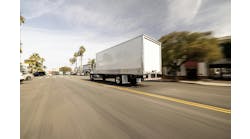U.S. trailer orders increased slightly in April, and while industry analysts point to an early-stage turnaround for fleet customers, freight rates and profitability—and therefore equipment purchases—remain tepid.
FTR reported trailer orders increased by 1,069 units to a total of 13,016, which is up 9% from March and 45% from April last year. Despite the gain, trailer orders were still 20% below the average for the last 12 months, according to FTR. The number of trailers ordered over the last 12 months increased to just over 199,000 units.
Trailer production, meanwhile, decreased by 3% in April, totaling 22,975 units. Production was down 12% year-over-year. This build level aligns with the average April level over the past five years, FTR added.
With orders coming in below production levels, backlogs fell “somewhat” in April, shedding 5,060 units to end at slightly more than 147,000 units. The decrease in backlogs would have been about twice as large if not for an OEM revision of backlogs that resulted in a roughly 5,000-unit increase for dry van and total backlogs, FTR noted. With production and backlogs declining by a similar degree, there was “no material change” to the backlog-to-build ratio, which remains at 6.4 months. This ratio, which is slightly below the average level for the last half of 2023 but is above the historical average before 2020, currently indicates “little overall incentive” for trailer manufacturers to adjust production levels.
“With the truck freight market facing challenges, solid growth in April for both total van and major vocational trailer orders offers a few green shoots of optimism,” Dan Moyer, FTR senior analyst, commercial vehicles, said. “Unless this growth continues in the coming quarters, decreasing backlogs and high dealer trailer inventory levels will put further downward pressure on trailer build rates.”
Muted impact
In delivering its preliminary monthly report, ACT Research found net trailer orders were little changed from March to April. However, at 13,700 units, orders were higher compared to last April, up 21% y/y. Seasonal adjustment (SA) at this point in the cycle boosts April’s tally to 17,300 units.
“Against year-ago data, with pent-up demand beginning to wane and supply-chain congestion, for the most part, cleared, order activity continues to meet expectations,” said Jennifer McNealy, director CV market research ad publications at ACT Research. “Despite the positive year-over-year comparison, net orders remain challenged by a backdrop of weak for-hire trucker profitability, albeit with some green shoots of improvement beginning to show. Anecdotal commentary from trailer manufacturers and suppliers through the past several months have indicated this slowing, as they have shared that orders are coming, but at a more tepid pace when compared to the last few years.”
However, while the research firm does see fleets starting to make more money later this year, the impact “likely will be muted” for the trailer industry, as ACT Research anticipates fleets will lean toward the purchase of new power units ahead of the EPA’s implementation of 2027 emissions regulations.
“Additional anecdotal information we’ve heard this month from those on the front lines of the trailer industry is that the ‘pause button’ is expected to remain pressed during this year of transition,” McNealy said. “The industry’s largest segments remain under pressure, cancellations are anticipated to continue their oscillation into and out of elevated territory as dealers and fleets recalibrate their inventory and immediate needs, and external forces like the US and Mexican presidential elections and interest rates remain on the closely watched list.”









